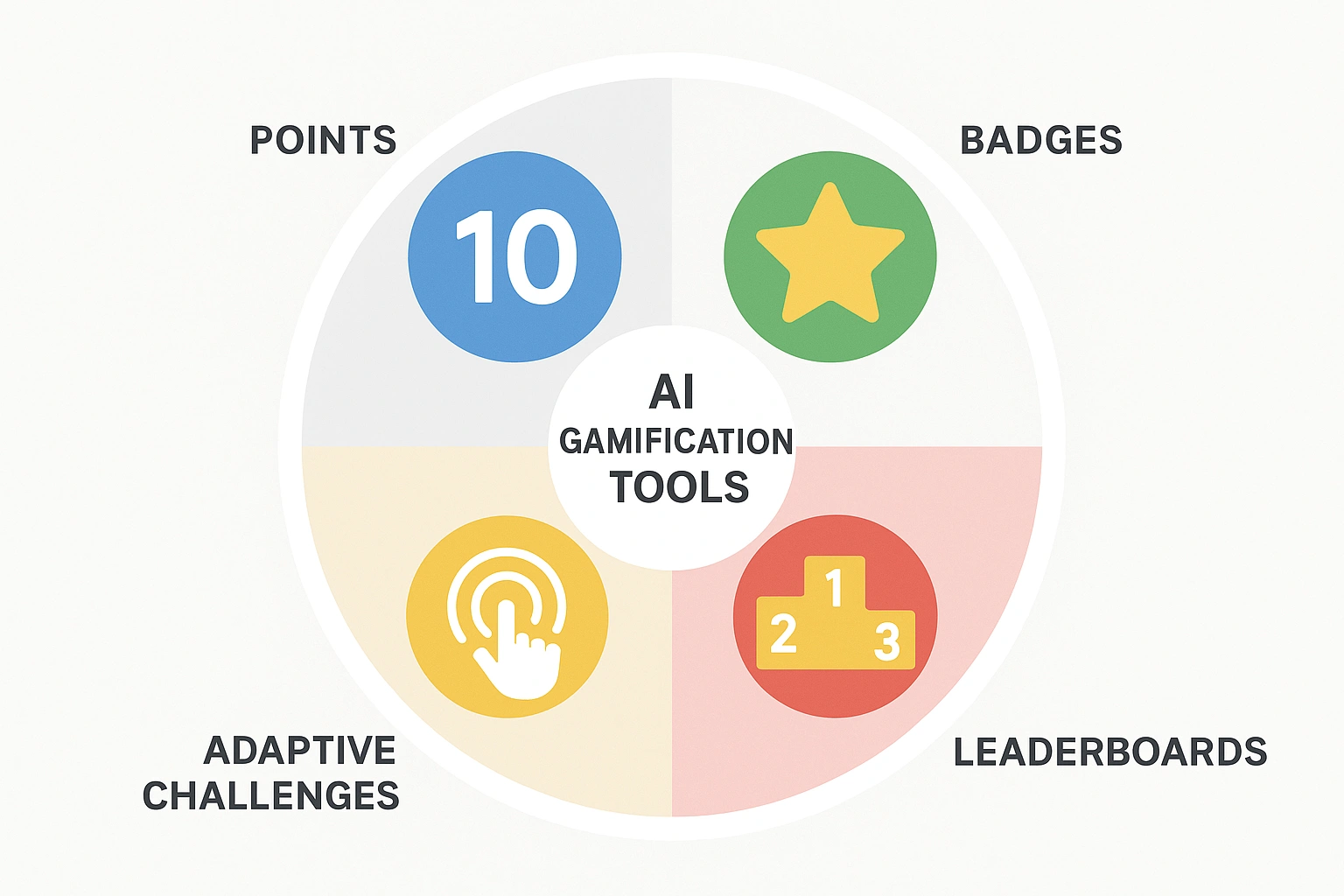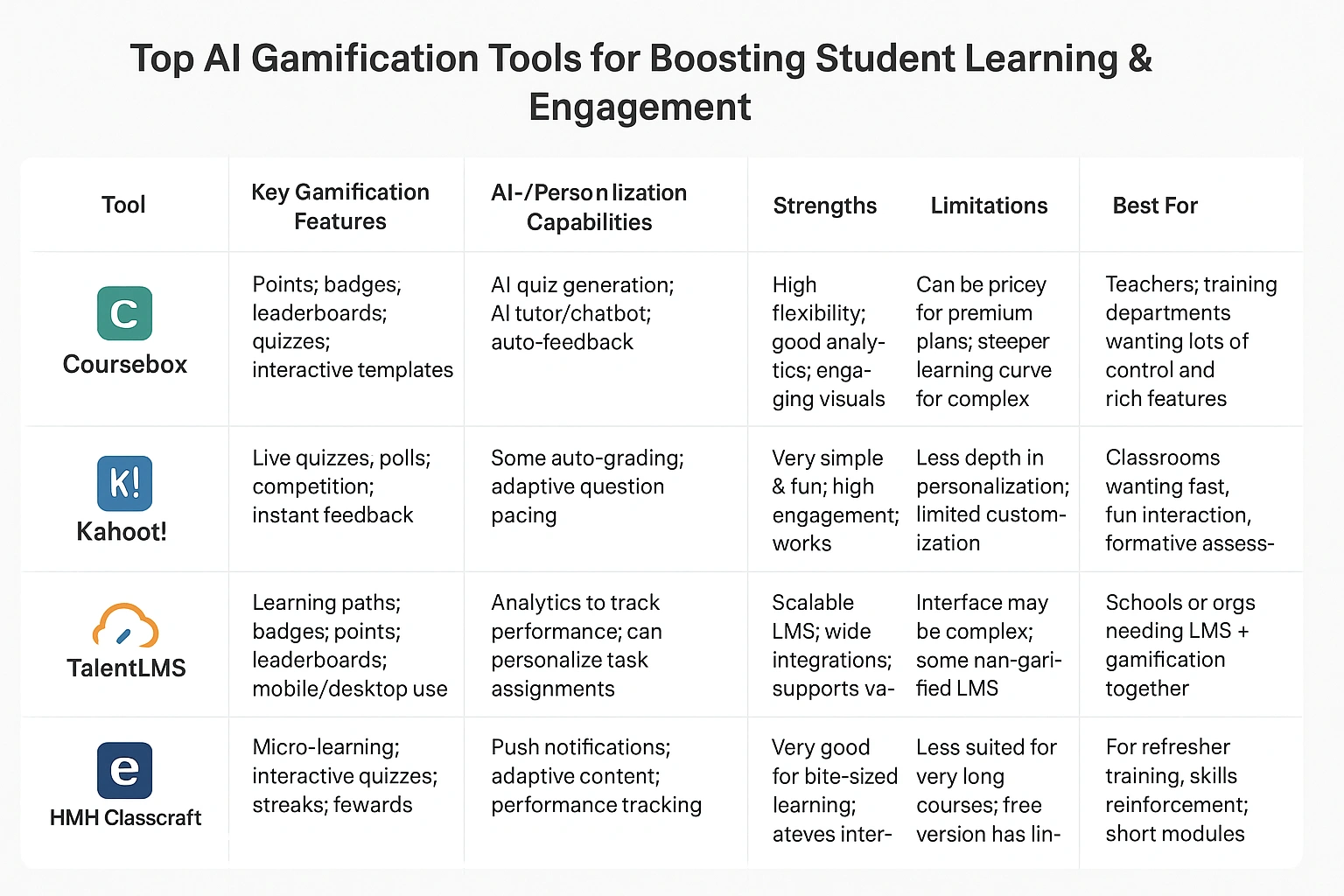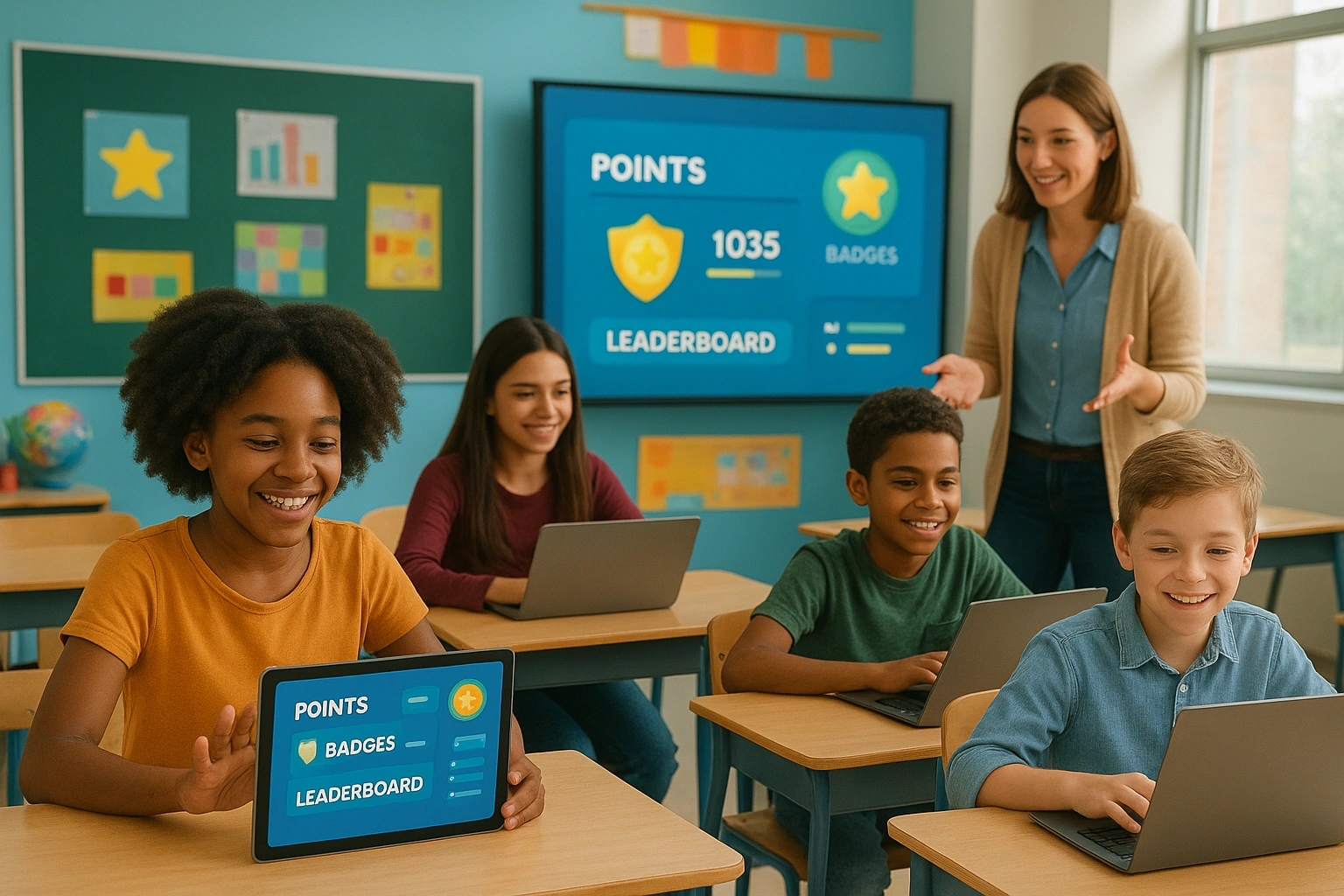Introduction
What Are AI Gamification Tools?
Simply put, AI gamification tools are educational software that apply game-design principles—like points, badges, leaderboards, and narratives—to academic content. The “AI” component is the secret sauce: it allows for personalization at scale. An AI engine can dynamically adjust the difficulty of challenges based on a student’s performance, create personalized learning paths, and provide intelligent feedback in real-time. This isn’t just about making learning “fun”; it’s about leveraging proven psychological motivators to drive academic progress. As noted by industry reports cited by Statista, the global gamification market is exploding, and education is one of its most promising frontiers. In 2025, these intelligent AI gamification tools are essential for turning passive learning into an active, rewarding adventure.

Why It Matters: The Benefits of Gamified Learning
Boost Intrinsic and Extrinsic Motivation
Gamification taps into both types of motivation. Points and leaderboards provide extrinsic rewards that drive competition and effort. More importantly, well-designed quests and challenges foster intrinsic motivation by providing a sense of autonomy, mastery, and purpose, making students *want* to learn.
Improve Knowledge Retention
Active learning is far more effective than passive consumption. Gamified tools encourage students to repeatedly engage with the material through practice and application in a low-stakes environment. This concept, known as “retrieval practice,” is one of the most effective ways to embed knowledge in long-term memory.
Create a Positive Attitude Towards Challenges
In a traditional setting, getting a problem wrong can be discouraging. In a game, it’s simply a chance to try again, learn from the mistake, and overcome the challenge. This reframes failure as a natural and essential part of the learning process, building resilience and a growth mindset. This kind of positive framing is an asset in any field, from academics to understanding complex data like financial reports.
Provide Immediate and Actionable Feedback
Instead of waiting days for a graded assignment, students receive instant feedback from AI gamification tools. They know immediately if they answered correctly and, more importantly, *why* an answer was incorrect. This instant feedback loop dramatically accelerates the learning cycle.
How It Works: The Core Features of Gamification AI
These platforms integrate several key game mechanics, powered by an underlying AI engine that ensures the experience is both engaging and pedagogically sound.
- Points and Experience (XP) System: This is the fundamental mechanic. Students earn points for completing tasks, answering questions correctly, and participating in activities. XP accumulates over time, showing a clear visual representation of their learning progress.
- Badges and Achievements: These are virtual rewards given for reaching specific milestones (e.g., “Grammar Guru” for acing a quiz, “Collaborator King” for teamwork). They provide recognition and tangible goals for students to strive for.
- Leaderboards: Publicly displaying top scores can foster a sense of friendly competition. The best tools offer options for individual, team-based, or even anonymized leaderboards to ensure the environment remains positive and inclusive.
- Narrative and Storylines: Many tools allow teachers to wrap their curriculum in a compelling story. A history lesson becomes a quest to uncover ancient artifacts; a science unit becomes a mission to colonize Mars. This adds context and purpose to the learning activities.
- AI-Powered Adaptive Challenges: This is the most advanced feature. The AI analyzes a student’s performance and tailors the difficulty of subsequent challenges. This ensures the “game” is never too hard to be frustrating or too easy to be boring—a state known as “flow.”

Real-World Use Case: A Review of ClassQuest AI
To see these principles in action, I used ClassQuest AI to gamify a middle school unit on ancient Egypt. I transformed the unit into a four-week “Quest for the Pharaoh’s Tomb.” Each week represented a new chamber in the pyramid, with daily lessons framed as “challenges” and quizzes as “guardians” that had to be defeated. Students earned XP for each completed task.
The AI’s role was crucial. It automatically assigned easier “hieroglyphics” practice to students who struggled on the initial quiz, while offering “expert challenges” on Egyptian mythology to those who were excelling. The class leaderboard, which I set to team-based, sparked incredible collaboration. Students were actively helping each other to boost their team’s score. Engagement skyrocketed. The final “boss battle”—a cumulative test—saw a 15% improvement in average scores compared to the previous year’s non-gamified unit.
| Pros | Cons |
|---|---|
| Rich narrative and quest-building tools | Initial setup of a quest can be time-consuming |
| Powerful adaptive learning engine | Visual theme might be too “gamey” for some older students |
| Excellent team-based competition features | Full feature set requires a premium subscription |
Comparison of Top AI Gamification Tools in 2025
The market is rich with options, each catering to different teaching styles and student needs.
| Tool | Key Features | Pros | Cons | Best For |
|---|---|---|---|---|
| ClassQuest AI | Narrative quests, adaptive AI, team leaderboards | Deeply immersive, highly customizable | Requires more planning upfront | Project-based units in K-12 |
| QuizLeap | Live competitive quizzes, power-ups, AI question generator | Fast-paced, exciting, easy to set up | Focus is on recall, not deep analysis | Review sessions and vocabulary drills |
| BadgeUp Edu | Micro-credentialing, skill trees, digital badges | Excellent for competency-based learning | Less focused on live gameplay | High school and vocational training |
| AdventureLearn | Choose-your-own-adventure stories, branching paths | Promotes critical thinking and decision-making | Content creation is more intensive | Humanities, social studies, and ethics |

Common Mistakes to Avoid
Gamification is powerful, but a poorly designed system can backfire. Avoid these common traps.
- Focusing on Rewards Over Learning: The game should always serve the learning objectives, not the other way around. If students are just clicking for points without thinking, the gamification has failed.
- Creating Unfair Competition: A leaderboard can be demotivating for students who are consistently at the bottom. Use team-based or anonymized leaderboards to mitigate this.
- One-Size-Fits-All Design: Not all students are motivated by the same things. The best platforms allow for different “player types”—some are driven by competition, others by exploration or collaboration.
- Making it Too Complicated: The rules of the game should be simple and clear. If students have to spend more time figuring out how to play than learning the content, you’ve lost them.
- Ignoring the Narrative: A compelling story is what separates a meaningful quest from a boring checklist. Take the time to build a simple but engaging narrative for your gamified unit.
Expert Tips & Best Practices
Elevate your gamification strategy from good to great with these expert insights.
“The magic of AI in gamification is its ability to maintain a perfect balance between challenge and skill for every single student simultaneously. This creates a ‘flow state,’ where learning feels effortless and time flies by.”
- Align Mechanics with Verbs: Match the game mechanic to the learning objective. Use quizzes for “recall,” collaborative challenges for “analysis,” and creative building tasks for “synthesis.”
- Start with a “Tutorial Level”: Begin your gamified unit with a simple introductory quest that teaches students the rules of the “game” and gives them an easy first win to build momentum.
- Offer Choice: Whenever possible, provide students with a choice of quests or challenges. This increases their sense of autonomy and ownership over their learning journey.
- Celebrate Progress, Not Just Victory: Use badges and shout-outs to celebrate effort, improvement, and collaboration, not just the students who finish at the top of the leaderboard.
Frequently Asked Questions (FAQ)
Q: Isn’t ‘gamification’ just a distraction from real learning?
A: When implemented correctly, gamification is not a distraction but a motivator. The core principle is to use game mechanics to enhance the learning process, not replace it. Effective AI gamification tools tie rewards directly to mastering academic concepts, making learning the central path to success in the ‘game’.
Q: How do AI gamification tools cater to different learning speeds?
A: This is a key strength of AI. These platforms use adaptive learning algorithms. They can automatically adjust the difficulty of challenges based on a student’s performance, ensuring that advanced learners are challenged and struggling students receive the support and practice they need to catch up.
Q: What age group are these tools best for?
A: Gamification is effective across all age groups, from elementary school to corporate training. The key is choosing a tool with age-appropriate themes, challenges, and reward systems. Many platforms offer customizable templates for different educational levels.
Q: Does it take a lot of time to create a gamified lesson?
A: Initially, there can be a learning curve. However, the best AI gamification tools are designed to streamline this process. They offer pre-built templates, AI-powered question generators, and intuitive interfaces that allow teachers to convert a standard lesson plan into an interactive quest in under an hour.
Q: How do you measure learning outcomes with these tools?
A: These tools provide robust analytics dashboards. Educators can track progress on specific learning objectives, view accuracy rates on quizzes, see time-on-task, and identify which concepts the class is struggling with as a whole. The data provides clear evidence of learning outcomes, far beyond simple game scores.
Conclusion
